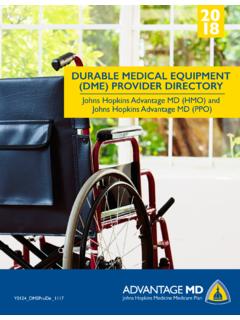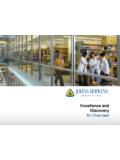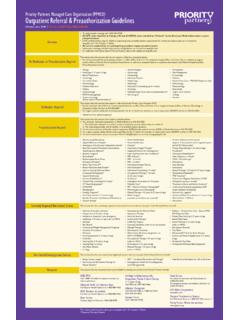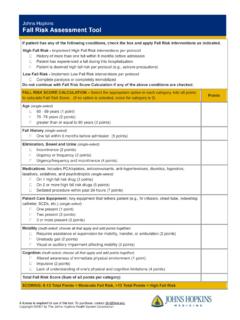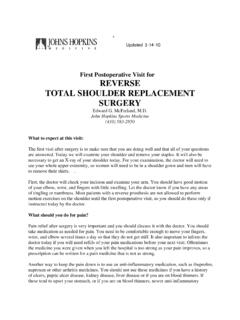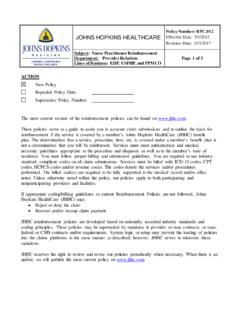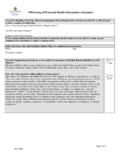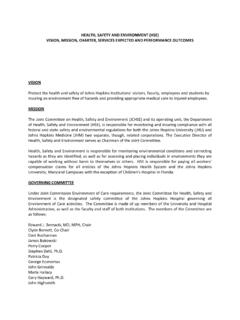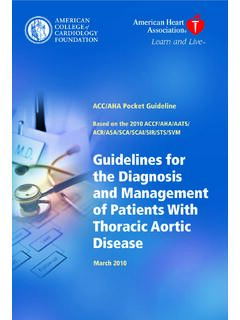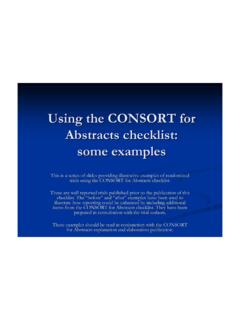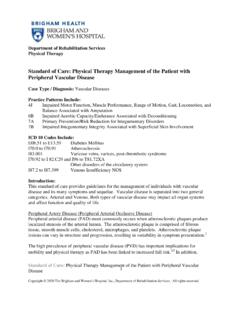Transcription of Gastroesophageal Reflux Disease: Introduction
1 Figure 1. Location of the pharynx,esophagus, and stomach in the Reflux Disease: Introduction Gastroesophageal Reflux is the involuntary movement of gastric contents to the esophagus. It is a common disease, occurring inone third of the population in the United States. However, Reflux is only considered a disease when it causes frequent or severesymptoms or when it produces injury. About 3 7% of the population suffers from frank esophageal Reflux disease. Mostreflux disease is not life threatening, as demonstrated by the relatively small number of patients (20%) who are admitted tohospitals with Gastroesophageal Reflux as the primary cause for admission. common complications of Reflux include esophagitis,esophageal strictures, and Barrett s esophagus. What Is GERD? Gastroesophageal Reflux is the involuntary movement of gastric contents to the esophagus (Figure 2).
2 Gastroesophageal Reflux is a normal physiological process thatoccurs several times a day without symptoms or damage of the esophageal mucosa in most otherwise healthy individuals. Gastroesophageal Reflux disease (GERD)is a condition in which Reflux of gastric contents into the esophagus produces frequent or severe symptoms that negatively affect the individual s quality of life or resultin damage to esophagus, pharynx, or the respiratory tract. Figure 2. Reflux of gastric contents into the typical presentation of Gastroesophageal Reflux disease is chest burning (often referred to as heartburn) and the regurgitation of sour or bitter liquid, sometimesmixed with food, to the throat or mouth. Although not everyone with Gastroesophageal Reflux disease has these symptoms, the combination of chest burning andregurgitation of sour or bitter-tasting food or liquid is so characteristic of Gastroesophageal Reflux that formal testing is often may also have non-burning chest pain and difficulty swallowing.
3 The chest pain is usually located in the middle of the chest and may radiate through to theback. Difficulty swallowing (dysphagia) may be due to abnormal esophageal motility or to an esophageal stricture. Symptoms may also arise from the throat, larynx, orlungs. These atypical Reflux symptoms, often referred to as extra-esophageal manifestations of Reflux disease, may include sore throat, coughing, increasedsalivation, and shortness of breath. Although it might be assumed that throat and airway symptoms would only occur in patients with esophageal symptoms, extra-esophageal manifestations can occur in patients without esophageal symptoms and without esophageal damage. Copyright 2001-2013 | All Rights North Wolfe Street, Baltimore, Maryland 21287 Gastroesophageal Reflux Disease: Anatomy The esophagus serves as a conduit between the pharynx and the stomach.
4 The body of the esophagus is approximately 18 25 cm long, extending from the upperesophageal sphincter (C5 C6 vertebral space at the junction of the pharynx and the esophagus) to the lower esophageal sphincter (T10 level at the junction of theesophagus and the stomach). The length of the esophagus correlates with an individual s height and is usually longer in men than in esophagus transports food from the mouth to the stomach in a caudad direction and prevents the retrograde movement of gastric or esophageal contents. It is ahollow tube closed at the upper end by the upper esophageal sphincter and at the lower end by the lower esophageal sphincter. The lumen is normally lined withnon-keratinizing stratified squamous epithelium. Underneath is a supporting layer of connective tissue called the lamina propria and a longitudinally oriented, thinlayer of muscle fiber (muscularis mucosae).
5 These three layers compose the mucosal layer. The submucosa consists of loose connective tissue, blood vessels,lymphatics, and nerves. The muscularis propria has two layers, an inner circular muscle layer with circumferential fibers and an outer longitudinal layer with fibersoriented along the axis. The muscle in the muscularis mucosae is smooth along the length of the esophagus, whereas the muscularis propria is composed of striatedmuscle in the most proximal portion. Smooth and striated muscle meet in the middle third of the esophagus. A network of intrinsic neurons is found in the submucosaand between the circular and longitudinal muscle layers, and, is capable of producing secondary peristalsis. This network communicates to the central nervoussystem via the vagi, the adrenergic ganglia, and the celiac ganglia (Figure 3).
6 Figure 3. Normal anatomy of the esophagus; A, anterior; B, lateral view showing esophageal regions. The esophagus is divided into four regions. The cervical esophagus extends from the lower border of the cricoid cartilage to the thoracic inlet (suprasternal notch) orfrom the cricopharyngeus muscle to approximately 18 cm from the gums. The trachea, vertebral column, and thyroid and carotid sheaths surround this portion of theesophagus. The upper thoracic esophagus extends from the thoracic inlet to the level of the tracheal bifurcation (18 24 cm from the gums). The mid-thoracicesophagus includes the proximal half of the esophagus from the tracheal bifurcation to the esophagogastric junction (24 32 cm from the gums). The thoracicesophagus passes posterior to the tracheal wall and posterior to the aortic arch and the bifurcation of the trachea and left bronchus.
7 Finally, the distal thoracicesophagus includes the distal half of the esophagus from the tracheal bifurcation to the esophagogastric junction (32 40 cm from the gums). The esophagus crossesanterior to the aorta and through the muscular diaphragm at the T10 level and enters the stomach. The abdominal portion of the esophagus is variable in length( cm). The esophagus is surrounded by collagen and elastic fibers at the level of the junction of the esophagus and the stomach lies caudad to the esophageal hiatus of the diaphragm. The phrenicoesophageal membrane anchors theesophagogastric junction to allow movement with respiration but to prevent significant (more than 1 2 cm) proximal movement of the top margin of the stomach. Thehigh-pressure zone of the lower esophageal sphincter (LES), the intra-abdominal segment of the esophagus, diaphragmatic crura, phreno-esophageal ligament,mucosal rosette, and angle of His form a barrier and limit refluxate into the lumen.
8 The high-pressure zone at this junction creates a barrier to the transfer of stomachcontents to the esophagus. Copyright 2001-2013 | All Rights North Wolfe Street, Baltimore, Maryland 21287 Gastroesophageal Reflux Disease: Causes Overview The pathophysiology of GERD is complex. The antireflux barrier is created by a combination of the normal anatomical configuration of the esophagogastric junction(EG) and the strength and function of the lower esophageal sphincter (LES).Figure 4. Mechanism of Gastroesophageal Reflux weak antireflux barrier causes Reflux in the majority of patients (Figure 4). Gastroesophageal Reflux disease most often occurs when LES pressure (measuredmanometrically) is low or the normal angulation of the EG junction is lost (as occurs when a hiatus hernia is present) (Figure 5).
9 Figure 5. A, Normal esophagogastric (EG) junction; B, hiatus hernia; A , B , endoscopic in which esophageal acidity is monitored over extended periods (continuous pH monitoring) have demonstrated that most normal individuals experience refluxon a daily basis (Figure 6).Figure 6. Continuous esophageal pH monitoring demonstrating physiological Reflux ( Reflux in normal individuals) is generally brief in duration, relatively infrequent, and occurs almost exclusively after meals and is caused by asudden relaxation of the LES that is not induced by swallowing. This type of relaxation, called transient spontaneous LES relaxation, is also the predominantmechanism of Reflux in patients with GERD. However, whereas transient spontaneous relaxation is responsible for 98% of Reflux events in normal individuals, itaccounts for only about 60% of Reflux events in patients with Reflux .
10 Most other Reflux events in patients with GERD occur when resting LES pressure is inadequate toresist the pressure within the factors contribute to the severity of Reflux . Weak or uncoordinated esophageal contractions (perhaps occurring in response to esophageal irritation from refluxdisease itself) delay esophageal clearance of refluxed material. This prolongs the duration of esophageal contact with refluxed digestive gastric contents. Saliva is aneffective natural antacid. Reflux often stimulates salivation, a potentially beneficial response that enhances dilution and neutralization of refluxed gastric contents. Ifthe rate of salivation is low, or if an individual is unable to swallow his own saliva, refluxed material remains in the esophagus for prolonged periods of time. Thisincreases the severity of esophageal irritation and the probability of esophageal symptoms of GERD occur because of the irritating nature of gastric contents.
